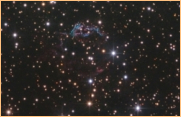

Nebulae

Nebulae are interstellar clouds of dust, hydrogen, helium and other ionized gases. Its a first stage of a stars life or its the
result of a stars death. There are four types of nebulae:
Emission nebula:
An emission nebula is a cloud of ionized gas emitting light of various colors. The most common source
for ionization are high-energy photons emitted from a nearby hot star. Most emission nebulae
show a dominant red color (Halpha line in HII regions).
Reflection nebula:
Reflection nebulae are clouds of interstellar dust which reflect the light of a nearby star or stars.
The energy from the nearby stars is insufficient to ionize the gas of the nebula to create an emission nebula,
but is enough to give sufficient scattering to make the dust visible.
Dark nebula:
A dark nebula or absorption nebula is a type of interstellar cloud that is so dense it obscures the light from objects behind it,
such as background stars and emission or reflection nebulae. The extinction of the light is caused by interstellar
dust grains located in the coldest, densest parts of larger molecular clouds.
Planetary nebulae and Supernova remnants:
A supernova remnant (SNR) is the structure resulting from the explosion of a star in a supernova.
The supernova remnant is bounded by an expanding shock wave, and consists of ejected material expanding
from the explosion, and the interstellar material it sweeps up and shocks along the way.
Nebulae, which are associated with a star's death (planetary nebulae or supernova remnants)
can show strong emission in the OIII line, whereby parts of the nebulae appear in a bluish/greenish color.
A planetary nebula, often abbreviated as PN or plural PNe, is a kind of emission nebula consisting of an expanding,
glowing shell of ionized gas ejected from old red giant stars late in their lives. The word "nebula" is Latin for mist or cloud
and the term "planetary nebula" is a misnomer that originated in the 1780s with astronomer William Herschel
because when viewed through his telescope, these objects appeared to him to resemble the rounded shapes of planets.
They are a relatively short-lived phenomenon, lasting a few tens of thousands of years, compared to
a typical stellar lifetime of several billion years
Emission nebula
Reflection nebula
Dark nebula
Planetary nebula





Supernova remnant


- CEDIC Team goes Chile II
- CEDIC Team goes La Palma I
- CEDIC Team goes La Palma II
- CEDIC Team goes La Palma III
- CEDIC Team goes Namibia
- Namibia 2022 - Intro
- #1 - Clusters in Carina
- #2 - Hidden Treasures in Vela
- #3 - Southern Galaxies
- #4 - Emission Nebulae in Centaurus
- #5 - Near South Pole
- #6 - Dark Nebulae in Cir & Lup
- #7 - Nebulae in Ara & Norma
- #8 - Nebulae in Scorpius
- #9 - Open Clusters in Scorpius
- #10 - Highlights in Sagittarius
- #11 - Nebulae in Ophiuchus
















